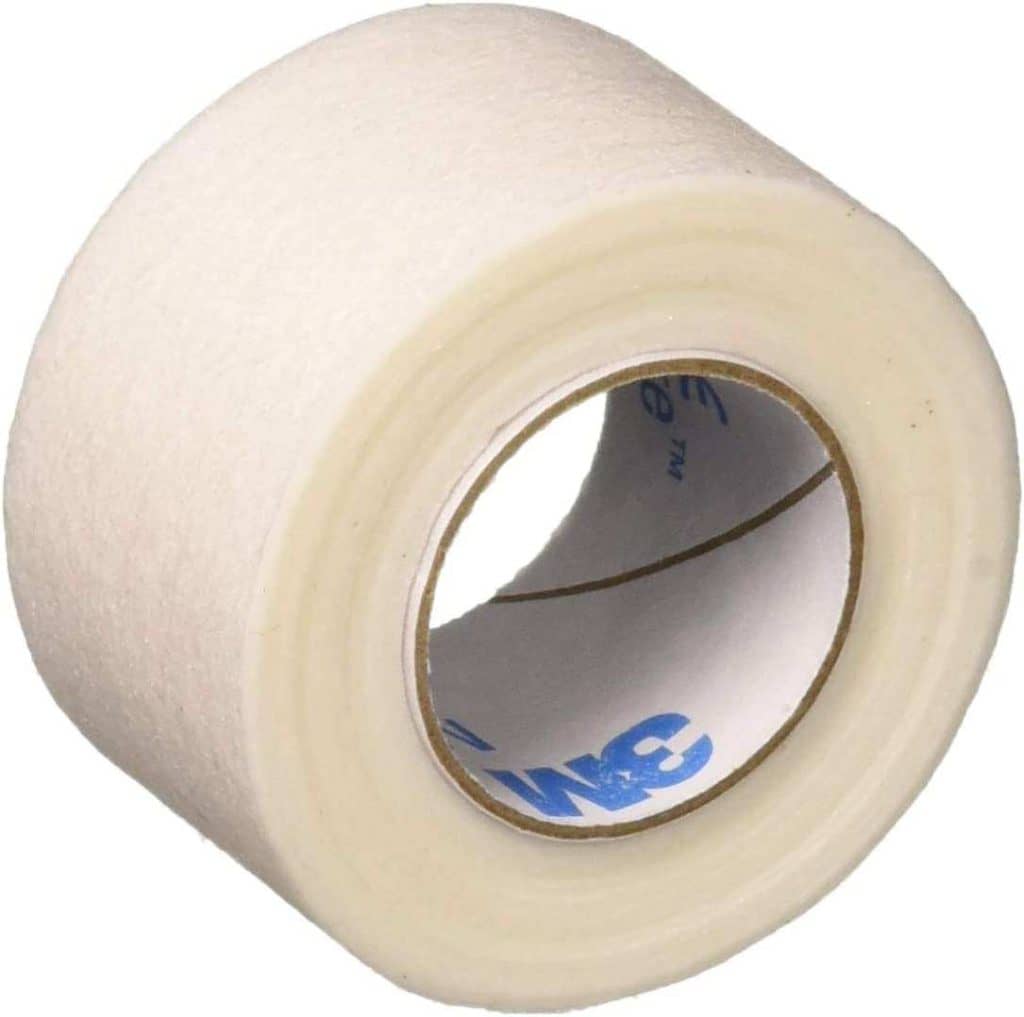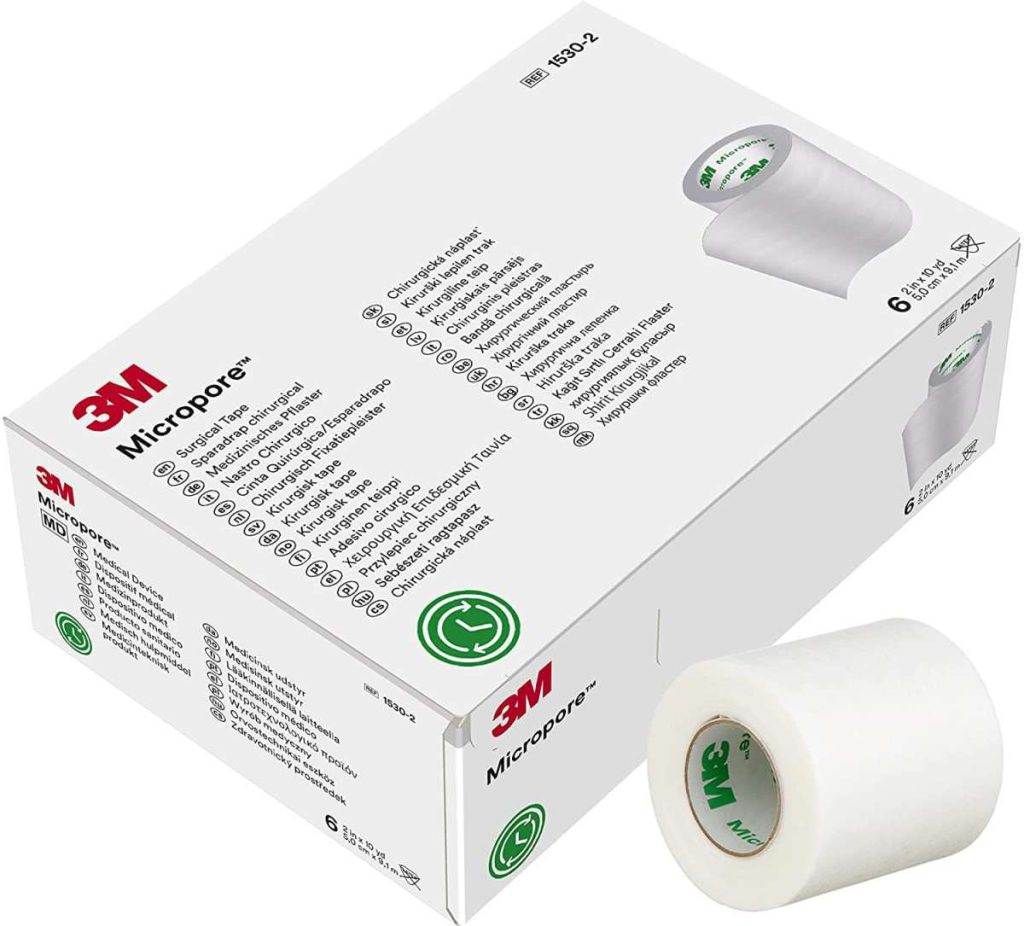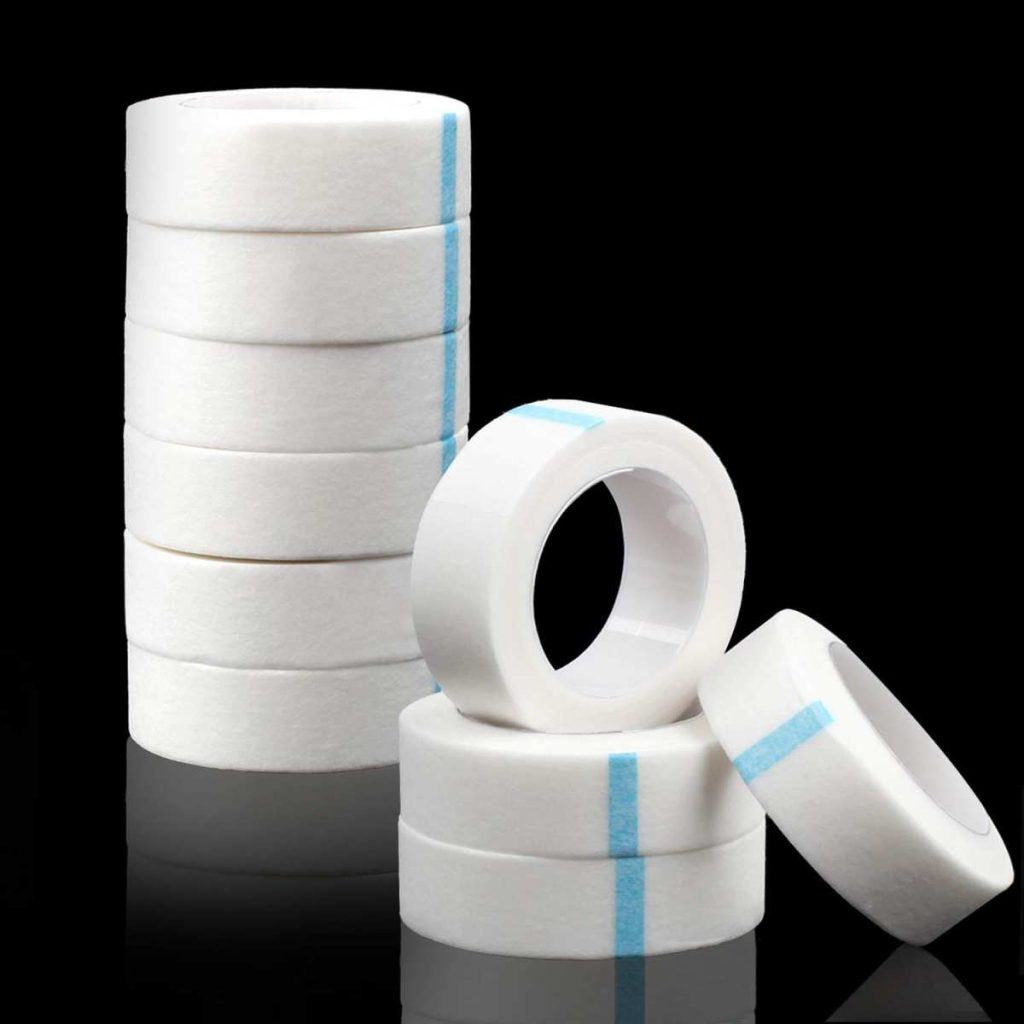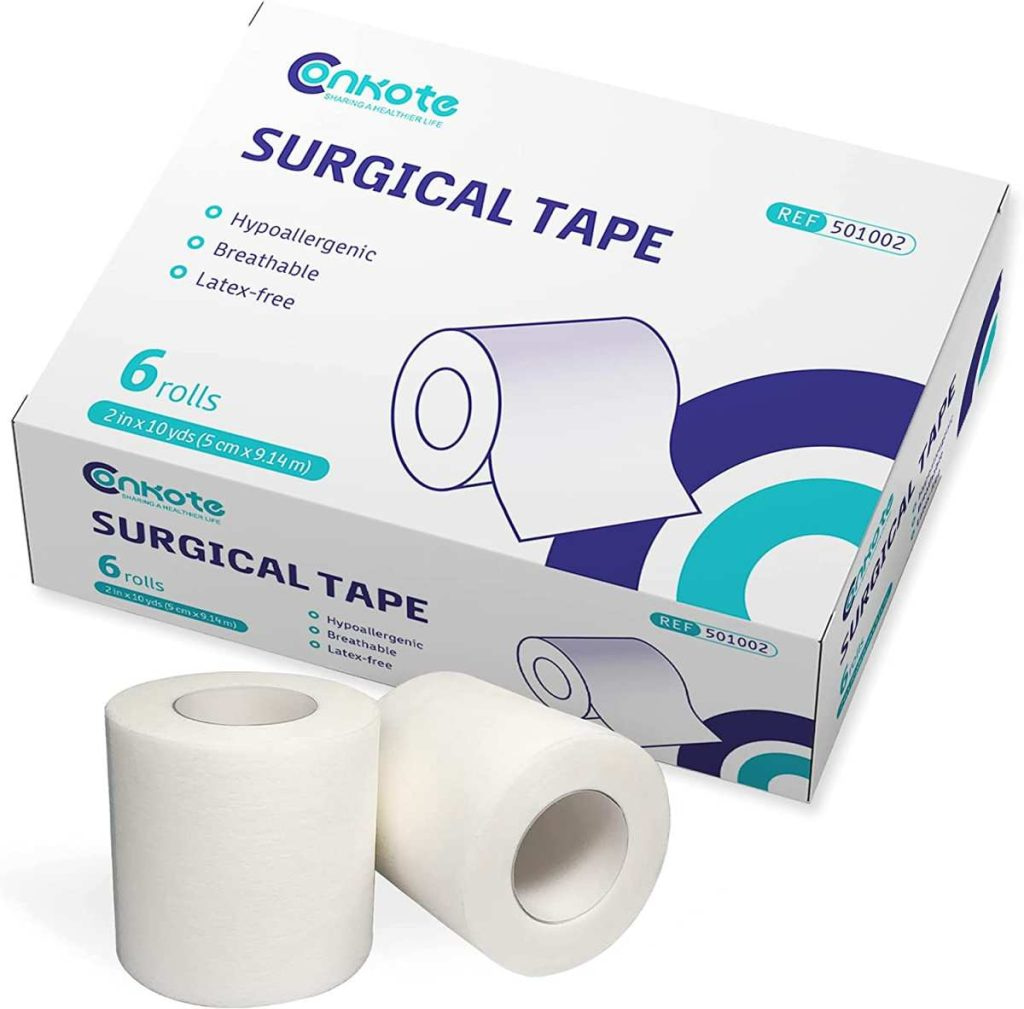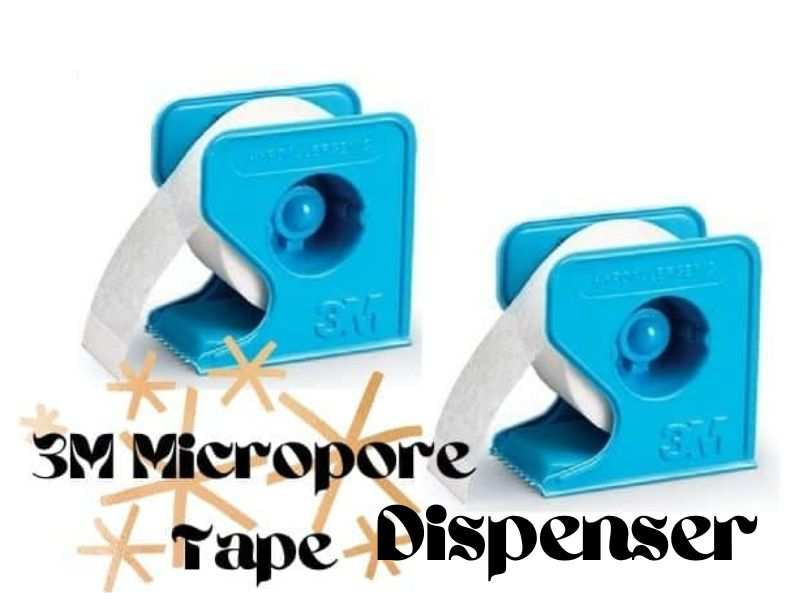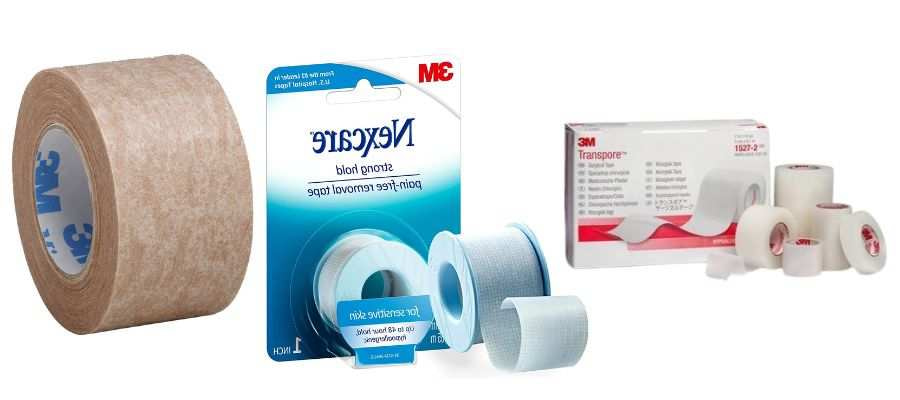Micropore tape, or sometimes called micropore medical tape, was developed by 3M, who has been around since 1902 and is considered the gold standard of all things medical tape-related.
While the name might be a bit confusing, this tape is nothing like regular painter’s tape that you’re probably used to seeing around your house.
Best Selling Micropore Tapes:
In fact, it’s quite different in terms of uses and quality. Here are some basics on what micropore tape actually is and how you can make use of it in your everyday life.
What is micropore tape?
Micropore tape is a skin-adhesive bandage that has been used by medical professionals since 1985. It is an alternative to traditional adhesive bandages and allows a person to remove, clean, and reapply it multiple times, making it ideal for cuts, abrasions and other types of minor injuries.
Though some people find micropore tape more irritating than traditional adhesive bandages, many find its performance worth it for cuts on their fingers or toes. Those with diabetes are also able to use micropore tape on their finger tips.
Read on for more information about what micropore tape is and how it works!
How does it work?
Micropore tape functions in much of the same way that a bandage does.
By putting it on certain areas, you’re providing protection, not to mention comfort. It works by applying pressure and traction in order to prevent water from entering your wound when showering or swimming. This allows for quick healing, pain relief, and risk reduction!
However, even though it is lightweight and transparent, micropore tape can also be used for cosmetic reasons. The adhesive backing is safe for use on all skin types and won’t damage your skin. This makes it great for those with sensitive skin or allergies!
Read: The Ultimate Guide to Choosing the Best Paper Shredder
Important tips for using micropore tape
The most important thing you can do is be patient. If you try to take it off quickly, you will inevitably leave some behind.
The tape’s adhesive sticks very well, but it’s also very thin, so it comes off more easily than other types of tape.
Take your time and get every inch of skin clean before applying the tape. Once you have applied it, just wait a few minutes for it to dry and then peel it off.
Don’t rush or press down on any areas—just let gravity pull at it until all of the glue has come up from your skin.
You should feel a little bit of tension when peeling if you did everything right; if not, there may still be some residue left behind that needs to be removed with alcohol or acetone.
Be sure to give yourself plenty of time between applying and removing micropore tape and washing up afterward. There is no hurry, so take advantage of that fact by allowing enough time for each step. This way you won’t have to rush through anything which could cause problems later on.
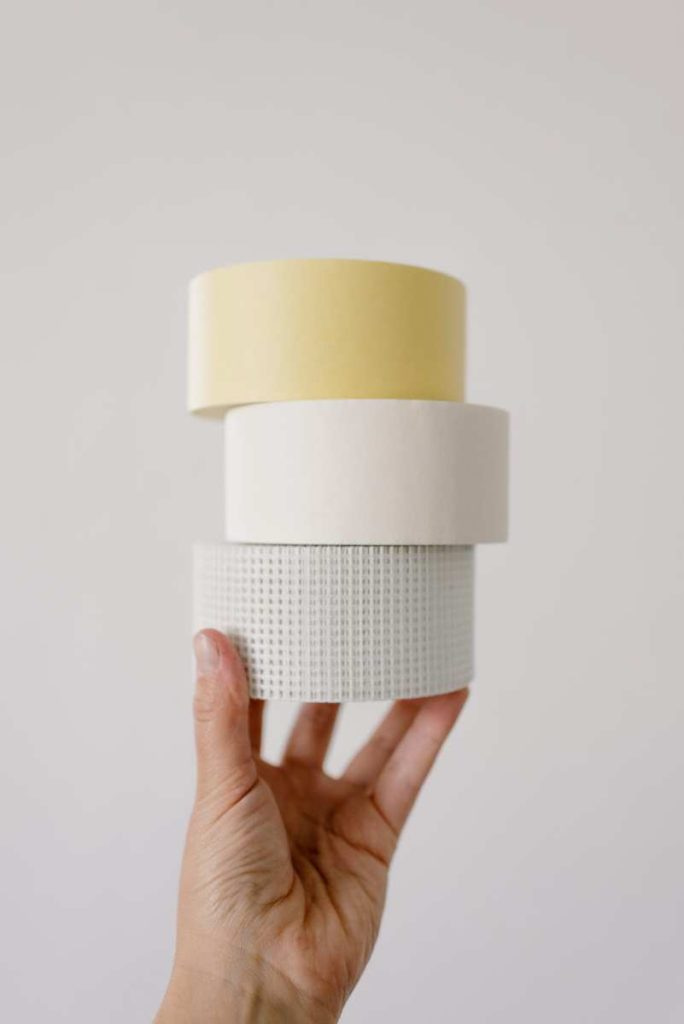
What are the best micropore tapes?
When looking for a micropore tape, there are a few different qualities that you should be aware of:
- Fit (how well does it stick?)
- Breathability (will your skin get sweaty or sticky when using it?)
- Washability (can you easily remove and reapply later on?)
- Transparency/Invisibility (if there is any coloration at all, is it noticeable?)
- Fragrance/smell (does it have an odor or will you smell like an adhesive factory after use?)
- Durability and Price (how long does each roll last? Is replacement required often?)
These are some pertinent questions that you should be aware of before zeroing in on a good quality micropore tape.
You can find all these answers by reading online reviews and checking out various online forums where people discuss their experiences with various tapes.
Types of Micropore Tapes
There are a number of different types of micropore tapes, each with their own unique qualities. The most common is simple Scotch® brand cellophane tape, which is easy to find and relatively inexpensive.
Another popular option is Elastoplast bandages, which work exceptionally well and come in a variety of sizes.
But if you’re looking for something that works better and lasts longer—and doesn’t need to be replaced as often—you can also opt for Micropore surgical tape or Bioclusive tape, both made by 3M.
Both have high adhesion properties, meaning they stay on your skin longer than regular tape. This makes them ideal for use during exercise or while swimming.
Some brands also offer hypoallergenic options if you have sensitive skin. If so, look for products labeled hypoallergenic or for sensitive skin.
Advantages of Micropore Tapes
- Comfortable and safe: Unlike other tapes, micropore tape is non-irritating. You can wear it for a long time without any irritation or allergic reaction.
- The thinness of micropore tape makes it more comfortable than other tapes, so you can wear it for longer periods of time without having to worry about excessive inflammation or pain from constriction.
- A little bit goes a long way with micropore tape, which makes it much more cost-effective than other types of medical tapes. With just one roll, you can treat multiple injuries at once.
- If you are an athlete who gets hurt often, then using micropore tape instead of traditional athletic tapes will save you money in both health care costs and athletic fees!
- As an added bonus, these tapes are hypoallergenic and latex free! That means they won’t irritate those with allergies or sensitivities.
- They are made from a soft cotton material that won’t leave behind fibers when removed.
- These qualities make them perfect for treating wounds in people who have undergone surgery as well as those with sensitive skin.
- There are many colors available as well as patterned rolls if you want something fun to look at while healing!
Where can I get micropore tape?
If you want to get a roll of tape, you can find them pretty much anywhere.
You can find it in almost any drug store or medical supply shop, as well as many places on Amazon and eBay.
You can also order them from any number of websites, though they might be more expensive than if you buy locally.
There are a few places that specialize in micropore tape and are worth checking out because they have interesting varieties or will allow special ordering.
Some of these include Medshop Express, Perforated Surgical Supply and Microcellular Sales Inc. Each one has their own inventory and specialty, so there’s something for everyone! Make sure to check with your doctor before buying from an online store!
Can I make my own micropore tape?
For some people, using a tape specifically designed for skin moles is more than enough. This may not be a big deal for you, but many people are looking for ways to DIY their micropore tape, and they want to know if they can make their own.
The answer? It depends on what kind of tape you have access to, but in most cases you can.
But let’s face it – making your own isn’t always ideal or practical. Making your own micropore tape means having to find a roll of medical grade adhesive tape that doesn’t contain latex.
You also need to find something sharp enough to cut off small pieces at a time (scissors won’t work). And then there’s all that tedious taping!
Sure, it will save you money and help you feel like an expert, but we think there are easier ways to go about things—like buying pre-made tapes from reputable sellers online.
How much does micropore tape cost?
Because micropore tape is often used for medical applications, it can be difficult to find pricing information. You may have access to a large supply from your local hospital or clinic.
Alternatively, you may be able to purchase a roll from a wholesaler. However, many businesses and individuals are starting to use micropore tape for non-medical purposes as well—you may find that you’re better off purchasing your own roll and reusing it multiple times over its lifespan.
Overall, since there isn’t much information on pricing out there yet, consider how much you’d pay in shipping fees alone if you were ordering online—this will give you an idea of how much a single roll might cost!
Alternatively, you can check some of these products on Amazon for their latest price.
How do I use micropore tape?
This one is simple. All you need to do is clean your skin with alcohol and then apply micropore tape over your incision or wound (or whatever part of your body you want covered).
The tape should only be worn for up to seven days after surgery, but it may also be used for up to five days for wounds or other medical issues that aren’t actively healing.
As a general rule, it’s not a good idea to wear micropore tape longer than that. It can slow down healing, prevent oxygen from reaching injured tissue, and cause skin irritation if worn too long.
But most people report that they only have problems when they leave micropore tape on their skin past five days, so it may just depend on your particular body chemistry as well.
You should get in touch with your doctor for the best advice.
A comparison of micropore tapes
First, it’s important to understand that not all micropore tapes are made equally.
They come in two different formulations: a natural type and a latex type.
The natural tape contains no latex, but some people may still be allergic even if they’re not actually allergic to latex.
Natural micropore tapes also tend to be thinner than their latex counterparts, so they offer better breathability and stay on longer. Some of these products are even waterproof!
They can cost more but are worth it for a comfortable experience during your recovery period.
If you have allergies or skin sensitivities, we recommend going with natural tape first before investing in latex tape, just in case you aren’t sensitive at all.
This is also great for children who haven’t yet developed an allergy to latex.
There are several brands of natural micropore tape on the market, including: Leukotape P, Nexcare Blister Relief Tapes, and Cohesive Bandage.
Leukotape P is very popular among runners as well as people who wear high heels frequently. It has been proven to reduce blistering when used correctly!
Let’s try to understand the difference between some popular tapes available around.
Read: Plotter Paper: An Ultimate Guide
How micropore tape compares with other tapes?
Micropore tape has a number of distinct features, giving it a look that makes it different from other types of tapes.
What does micropore tape look like?
The color of micropore tape depends largely on its width; most brands offer options ranging from 1/2 inch wide (for small cuts) up to 2 inches wide (for larger wounds).
Some brands even make colored tapes; however, these are designed more for looks than function.
Typically, micropore tape comes in white or clear colors.
In this section, we will examine how micropore tape fares when compared to different types of popular tapes.
Read: Everything You Need to Know about Cardstock Paper
FAQs
What kinds of uses are there for micropore tape?
There are many different ways you can use micropore tape. For example, you can use it on a surgical incision to keep things clean and prevent scarring; on a broken bone to keep particles out and allow your body’s natural healing process; or even just as a bandage in case of minor cuts.
How do I use it?
Micropore tape is used in combination with 3M Coban Adhesive Wrap. The process begins by applying adhesion wrap across your skin, directly above where you will be applying micropore tape.
This allows for extra protection from dirt/dust/grime that may get onto your wound or incision. Once applied, apply one piece of micropore tape overtop of your adhesive wrap. Then repeat until finished!
Can I reuse my micropore tape?
Unfortunately no, once removed from its original packaging it cannot be reused. It has been sterilized, so it is safe to use, but once removed from its packaging it loses its sterility and should not be reused.
Why does my package say sterile?
Your package says sterile because each roll has been sterilized after being manufactured. Sterilization ensures that each roll is free of any germs or bacteria, so you don’t have to worry about infection when using them.
Does micropore tape require any special care?
No, micropore tape is very easy to take care of. After removing it from its packaging, simply throw away. You can also dispose it off with other medical waste if you prefer.
Can I put micropore tape on an open wound?
Yes, however, make sure that you first cover your open wound up with 3M Coban Adhesive Wrap before applying your micropore tape to ensure maximum protection against outside contaminants getting into your open wounds or incisions while they heal.
Are there any side effects associated with using micropore tape?
No, however, if irritation occurs, discontinue use immediately and consult a physician if necessary.
How long should I leave micropore tape on for?
If you’re using it as a bandage, leave it on for at least 24 hours. However, if you’re using it to treat an open wound or incision, then leave it on until your doctor tells you otherwise.
How much does micropore tape cost?
The price of micropore tape varies depending on where you buy it from. It is typically sold in small packages containing one roll, which can range anywhere from $5-$10 depending on what brand you’re buying and where you’re buying it from.
Is there a way I can get free samples of micropore tape?
Yes, many companies will provide free samples if you ask for them. If not, then you can always try searching online for micropore tape coupons or micropore 3M adhesive wrap coupons, as many websites offer discount codes that will allow you to purchase these products at a reduced price.
What are some alternatives to micropore tape?
There are several alternatives to micropore tape, including other brands such as Opsite Flexifix and Tegaderm. However, each brand has its own pros/cons so make sure you do your research before making your final decision!
Can I use micropore tape on my face?
No, do not use any type of bandage product on your face unless instructed by a doctor.
Can I use micropore tape with children?
Yes, however, keep in mind that young children may be more likely to rip off their bandages than adults, so make sure they don’t have access to their wound while they’re healing.
Can I wear micropore tape while showering/bathing?
Yes, you can wear micropore tape during bathing. Just make sure that once you’ve finished washing up, you let your skin dry completely before applying a new layer of bandage over top of it.
Can I sleep in micropore tape?
Some people choose to sleep in their micropore tapes, but it isn’t recommended as sleeping causes our bodies to release natural oils and fluids onto our skin, which may cause an increased risk of infection if left untreated.
Does everyone need to apply ointment after using micropore tape?
Most doctors recommend applying ointment over top of any bandages used on wounds, but some patients may find that using ointment causes additional irritation to their wounds, so speak with your doctor about whether or not ointment is right for you!
Where should I place my micropore tape?
Always place your micropore tape directly over your wound, never directly on healthy skin. This ensures that you won’t experience any unnecessary pain when removing your bandage later on down the road.
When should I remove my micropore tape?
After 48 hours, remove your bandage and re-apply a fresh layer of medical grade dressing over top of it.
Do not re-use old layers of medical grade dressing as doing so increases risks of infection and could lead to serious complications further down the road.
You will be better off with your doctor’s consultation.
Are there certain types of wounds that shouldn’t be treated with micropore tape?
Yes, do not use any type of medical grade dressing or adhesive strip on open cuts/wounds unless instructed otherwise by a doctor.
What are some of the popular micropore tape brands?
If you’re not familiar with micropore tape, here are some of its most popular brands: 3M, Blenderm, and ClearPrep.
But there are many more options that might suit your needs even better.
Other famous microtape brands are:-
– 3M Micropore Transparent Dressing Tape (1/2 in x 10 yd)
– 3M Micropore Transparent Dressing Tape (1/2 in x 25 yd)
– 3M Coban Self-Adherent Wrap, 1 inch x 5 yards, White
– Blenderm Skin Prep Pouch with Dispenser Box, 4 inch x 6 inch, 24 Count
– ClearPrep Skin Cleanser Pouch with Dispenser Box, 4 inch x 6 inch, 24 Count
Why should I buy micropore tape?
Even if you don’t plan to use it every day, having some around can help ensure you always have what you need when accidents happen. You never know when a scraped knee or other minor injury will crop up, so keeping some micropore on hand is smart planning for any parent. But if you’re looking for a reason beyond convenience, there are plenty of benefits to using such a versatile product.
If you wish to know more about Micropore tape, you can visit the manufacturer’s website here.
Conclusion
This article provides a good insight on micropore tape and its usage. We hope you find everything you are looking for in our guide and continue to check back regularly for updates. Don’t forget to let us know what you think!
If there is something you feel is missing, confusing, or just needs clarification, let us know, and we will take a look at it. Good luck with all of your micropore tape purchases! We wish you nothing but success.

Avni Deopura
Content Writer
An SEO Expert, a Prolific Content Writer, and a dreamer currently pursuing a postgraduate degree in Master of Science in Psychology from St. Joseph’s College of Arts and Science. She is working as a Content Producer and Social Media Analyst.
The End of — “The Beginner’s Guide to Micropore Tape“

